When Donald Smith drove Canadian Pacific’s last spike in 1885, the city of Vancouver did not yet exist and Port Moody, the railroad’s original terminus, housed only about 250 people. All of British Columbia held about 50,000 residents, half of which were indigenous peoples who were unlikely to make much use of the railroad, and many of the rest didn’t live anywhere near the railroad. Alberta and Saskatchewan combined had even fewer residents and Manitoba didn’t have many more.
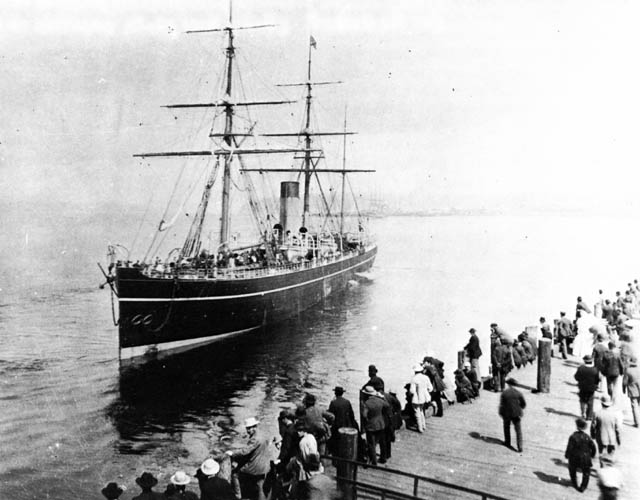
Canadian Pacific enters the steamship business as the Abyssinia leaves Vancouver on its maiden voyage in 1887. Built in 1870, the ship has three masts for sails as back up in case of engine failure. Click image for a larger view from the Chung collection.
The railroad’s first problem, then, was to generate enough business to keep its engines lubricated. One way of doing so was to open up trade with the Far East so that the railroad could become a transportation link between Europe and Asia. To promote this link, Canadian Pacific leased three ships that had been built in 1870 for the Cunard Line. These ships were obsolete in Atlantic service, but were better than anything that had been seen before between Canada and Japan. CP put them to work between Vancouver and Yokohama.
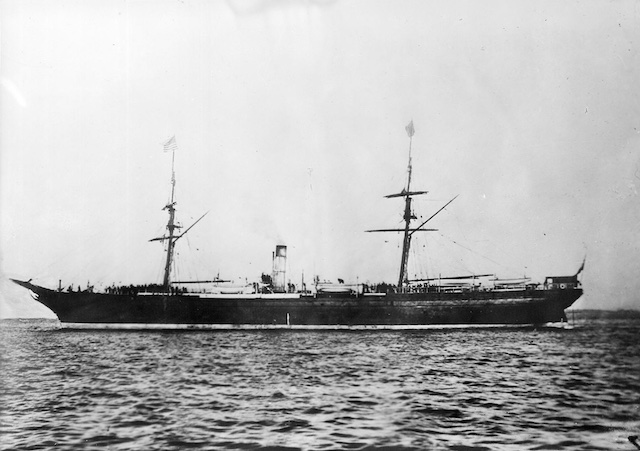
Unlike the triple-masted Abyssinia and Parthia, the smaller Batavia had only two masts. Click image for a larger view of this photo from the Chung collection.
Two of these ships, the Abyssinia and Parthia, were about 360 feet in length and originally accommodated 200 passengers in first class and 1,050 in steerage. They were probably reconfigured for CP service, but steerage was important in the early years of ocean liners as immigrants made up 90 percent of North American steamship passengers and generated half of ocean liner revenues.
The third ship, the Batavia, was smaller, about 327 feet long, and presumably carried a proportionately smaller number of passengers. CP also contracted out to an import company, Adamson, Bell, to manage the ship operations.
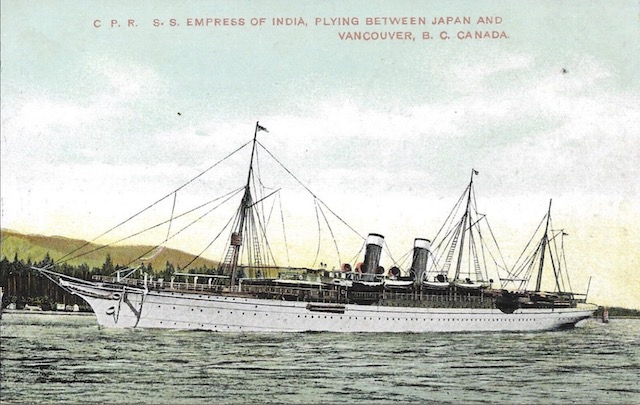
Hand dated 1909 on the back, this card shows the Empress of India, but it could just as easily be one of its sister empresses, China or Japan. Click image to download a 172-KB PDF of this postcard.
The ships were successful enough that Canadian Pacific ordered its own fleet of steamships that were larger, faster, and more luxurious and had plenty of room in cargo holds for high-valued imports such as tea and silk. These were the first empresses: the Empress of China, Empress of India, and Empress of Japan. While the ex-Cunard ships trundled along at 12.5 knots, the empresses cruised at 16. India started its maiden voyage on February 8, 1891, while Japan followed on April 11 and China on July 15.
The sister empresses were 456 feet long and were configured to carry 120 first-class passengers, 50 second class, and 600 in steerage. In general, first class meant private staterooms and sometimes private baths; second class meant private staterooms and shared baths; third class meant shared rooms with perhaps 8 to 12 bunks per room; and steerage meant dorms with up to 50 bunks or more. Each of the classes also had their own dining rooms, lounges, and recreation facilities as well as very different food offerings.
By the time the India-class ships arrived, Canadian Pacific had gained enough familiarity with ocean liner services that it operated the new ships itself rather than contracting out to another company. To support the ships, it convinced the British government to give it the contract to carry mail between the east coast of Canada and Hong Kong, thus allowing it to advertise the empresses as Royal Mail ships.
In 1903, Canadian Pacific entered the Atlantic market by buying the Beaver Line, which operated several ships in the Quebec-Liverpool route. These included the 446-foot-long Lake Champlain, sister ship Lake Erie, 470-foot Lake Manitoba, and its sister ship, Lake Michigan.
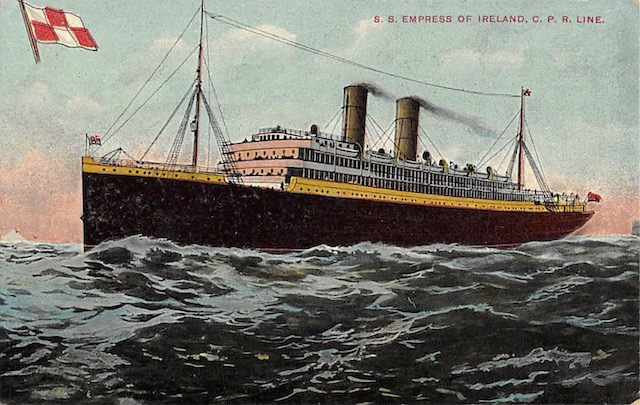
The Empress of Ireland entered service in 1906 and was tragically sunk in 1914. Click image to download a 180-KB PDF of this postcard.
CP soon ordered its own ships for Atlantic service, the Empress of Britain and Empress of Ireland, for this route. At 570-feet long with capacities of more than 1,500 passengers, these were much larger than anything it had previously owned and could cruise at 18 knots. Britain began its maiden voyage on May 5, 1906, and Ireland on June 29 of the same year.
At the same time, CP reconfigured the Lake-series steamships to replace their first- and second-class cabins with “cabin class”: all cabins were the same class, which was really second class (shared toilets). CP also called this “monoclass” even though the ships also had a third class, meaning shared cabins. In later years this third class was sometimes called tourist class.
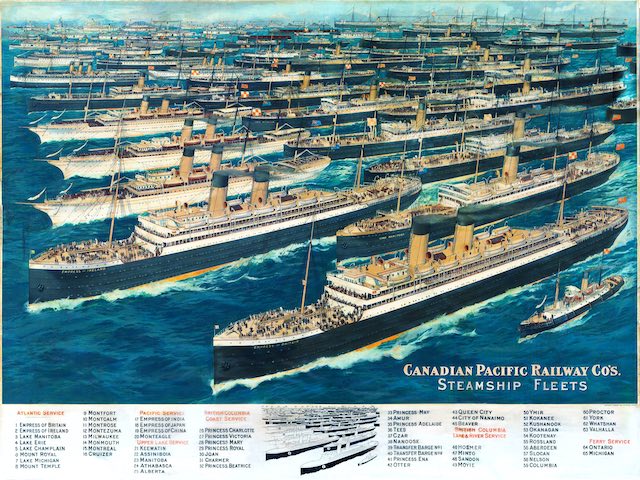
This 1910 poster shows Canadian Pacific’s 65-ship fleet, including 16 in Atlantic service, 4 in Pacific service, 20 in British Columbia coastal service, and 25 in lake, river, or ferry services. Click image for a larger view.
In 1911, the Empress of China, running in thick fog, struck a rock in Tokyo Bay. All passengers and cargo were rescued but the ship ended up being scrapped. In response, Canadian Pacific ordered two new Pacific empresses, the Empress of Asia and Empress of Russia. Russia started its maiden voyage on April 1, 1913, and Asia shortly after. These ships could run at 19 knots and were approximately the same dimensions as the Britain and Ireland but configured to carry 1,100 to 1,200 passengers.
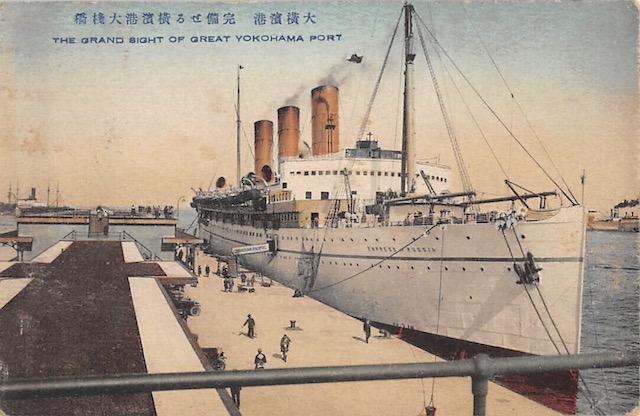
Posted in 1930, this card shows the 1913 Empress of Russia docked in Yokohama. Click image to download a 256-KB PDF of this postcard.
A more serious tragedy took place on May 29, 1914, when the Empress of Ireland collided with a Norwegian cargo ship in the St. Lawrence River. The empress sank in just 14 minutes, allowing little time to lower lifeboats. More than 1,000 lives were lost, making this the biggest maritime disaster in Canadian history.
Canadian Pacific filled in the gap created by the loss of the Ireland by chartering a smaller ship called the Virginian from the Allan Line. This ship only made a couple of round trips before World War I began and most Canadian and British ships were pressed into military service.
World War I marked a turning point in Canadian Pacific steamship history. Thirteen Canadian Pacific ships were lost, 11 to enemy action and 2 to accidents. After the war, the British Admiralty retained seven more, the greatly depleting the company’s fleet.
Canadian Pacific emerged from the war with four empress-class ships built for the Pacific route: the aging India and Japan and more recent Asia and Russia, plus two Atlantic empress ships, the Britain and France. In addition to the Lake-class ships that were in cabin service on the Atlantic route, CP had ordered four new monoclass ships just before the war began, the Missanabie, Metagama, Melita, and Minnedosa. These were impressed into wartime service as soon as they were completed. The Missanabie was sunk by a German torpedo, but the others were returned to CP after the war.
In addition, CP had purchased a controlling interest in the Allan Line before the war, but didn’t immediately integrate its operations with its own steamships. It did so after the war, giving the company a fleet of medium-sized ships like the Virginian plus at least one larger ship.
As a result, Canadian Pacific Ocean Services, as the company started calling its trans-oceanic steamship business in 1915, emerged from the war stronger than ever. What followed was two decades that can only be described as the golden age of Canadian Pacific ocean liners.
This post will be continued on February 15.
